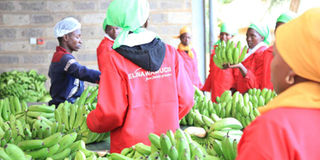Brief news on farming and agribusiness from around the country

Employees sort and grade fresh bananas for the export market. Stakeholders in the fresh produce export sector have asked the government to address challenges facing the industry, in particular the fumigation of produce. FILE PHOTO | NMG
What you need to know:
- Exporters said countries in the European Union (EU) and Australia have warned that they may ban produce from Kenya if it is not fumigated at the source.
- Fresh Produce Exporters Association of Kenya (FPEAK) CEO Hosea Machuki said the fumigation challenge has been compounded by limited supply of the requisite chemicals.
- The event organised by the Livestock Breeders Trust, is expected to attract more than 80 organisations that support the sector.
- For fish farming to thrive in cold regions, technologies such as greenhouses, larger fingerlings and selective breeding for improved cold tolerance need to be developed.
Fresh produce exports face threat
A large share of Kenya’s horticultural exports risk ban if the government does not address challenges facing the industry, in particular the fumigation of produce.
Exporters said countries in the European Union (EU) and Australia have warned that they may ban produce from Kenya if it is not fumigated at the source.
“Their concern is that the current fumigation of produce in the destination market exposes them to pests and diseases, which is a justifiable safety precaution, given the emergence of pests such as Fall armyworm,” said Okisegere Ojepat, the CEO of Fresh Produce Consortium of Kenya.
Starting August, the Australian market has demanded that fumigation of produce be undertaken at the source country. But Kenya is not ready for the move.
Fresh Produce Exporters Association of Kenya (FPEAK) CEO Hosea Machuki said the fumigation challenge has been compounded by limited supply of the requisite chemicals.
“For instance, methyl bromide, which is registered by the Pest Control Products Board (PCBP) is currently only shipped in by Amiran but they feel it is not cost-effective to bring it in,” said the FPEAK CEO.
He asked PCPB to fast-track the approval and registration of other chemicals.
FPEAK chairman Apollo Owuor cited other challenges such as electronic certification system downtimes, limited staff at airport, high cost of inspections on the farms by Kenya Plant Health Inspectorate Service and common user fumigation and cold treatment facilities.
Trade CS Peter Munya and Principal secretary, Dr Chris Kiptoo, pledged the government will strive to address the challenges.
-Brian Okinda
****
Livestock breeders’ show set for August 9
A livestock breeders’ show and sale will be held at Jamhuri Park, Nairobi from August 9 to 11.
The event organised by the Livestock Breeders Trust, is expected to attract more than 80 organisations that support the sector.
According to the chairman of the event’s committee, Dr Muchemi Kariuki, the exhibition has been held every two to three years since 1999 and is among the five biggest shows in Africa, exclusively dedicated to livestock and agriculture.
Its objective is to promote the Kenyan industry through exhibition of superior livestock, such as cattle, sheep and goats.
Also on display will be livestock health and nutritional products and modern farming technologies.
“During previous shows we had up to 34,000 people attending, including regular visitors from Ethiopia, Uganda, Tanzania, Zambia and South Africa,” said Dr Kariuki.
Key activities expected at the forthcoming show include judging of livestock by international judges, seminars, grand parade of livestock on exhibition and an auction of the finest stud.
-Brian Okinda
****
Large size fingerlings increase fish production: Study
Fish farmers can enhance their productivity by stocking the right fingerling sizes and setting up farms in warmer regions, a new study reveals.
The growth trial was conducted in Kisumu and Karatina Universities to determine the optimal production methods for different tilapia strains.
The study by Farm Africa and WorldFish found that in cold areas such as central Kenya, the growth of fingerlings was imperatively slower in terms of weight gain and food conversion ratio.
For fish farming to thrive in cold regions, technologies such as greenhouses, larger fingerlings and selective breeding for improved cold tolerance need to be developed.
The experiment further suggests that fingerlings should be sourced from a hatchery located within the same production area as those produced and farmed in the same geographic area are more productive since they are better adapted to the local environment.
“Fish farmers across the country need to look at aquaculture as a lucrative business. With this evidence-based results, farmers will be able to make informed decisions. We don’t want to replicate the quail story again in aquaculture value chain,” said Sven Genschick, a researcher at WorldFish .
Fish farming is a major contributor to the country’s food nutrition security, income generation and employment.
Factors such as climate change, hyacinth, over-fishing and industrial pollution continue to adversely impact on marine and lake fishing.
“We want to create a tipping point in the industry. Although ‘eat more fish’ campaign in the country has borne fruit, farmers need to study the market first before venturing into fish farming,” noted Arnoud Meijberg, an expert at Kenya Market-led Aquaculture Programme(KMAP)
He cited that one of the major obstacles experienced by farmers is the extremely high cost of feeds.
“If that was to be addressed through e.g. government subsidies, the level of production would soar thus filling the existing supply deficit,” said Mr Meijberg.
-Leopold Obi and Elizabeth Ojina





